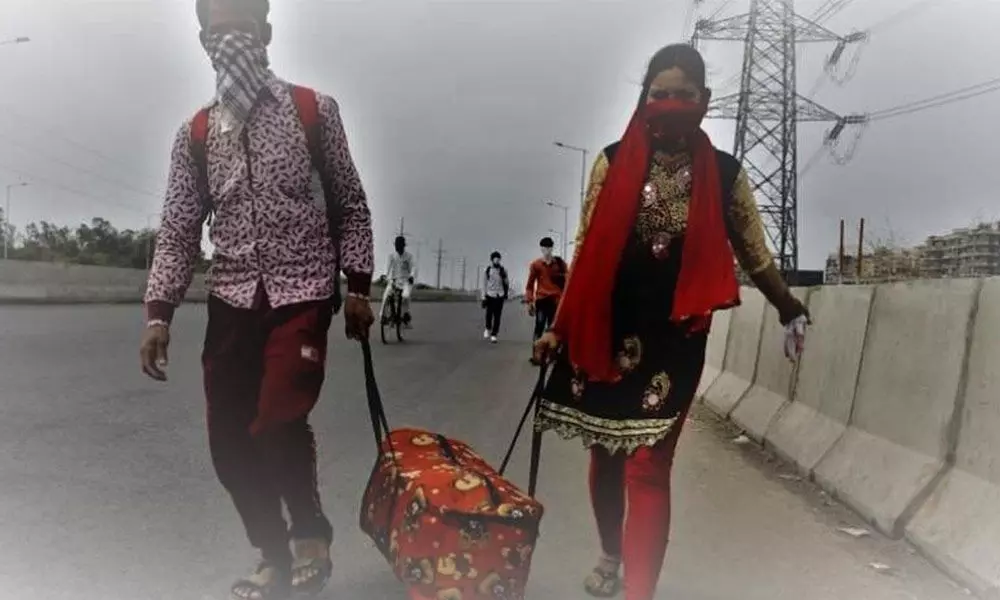India's deep economic paralysis just set in

India’s deep economic paralysis just set in
The National Statistical Office’s latest GDP data for 2020-21 fiscal reiterates what was expected
The National Statistical Office's latest GDP data for 2020-21 fiscal reiterates what was expected. But, for the current financial year, it indicates the country's economy already slipping into a deep paralytic state. Lack of demand and consumption in rural areas that sustains two-thirds of the country's population is the reason behind this. This is also despite the agriculture being the only sector that registered a positive growth with a gross value added of Rs. 20.40 lakh crore in 2020-21. This year the monsoonis going to be above normal as well.
Between 2019-20 and 2020-21, India's GDP has reported a loss of Rs. 10.56 lakh crore, or a -7.3 growth. But the data on consumption reiterates what was mostly expected: the economic slowdown led to en mass reduction in private consumption. Without this, no economy would even sprout. Private consumption expenditure that accounts for 56 per cent of the country's GDP in 2020-21 has reduced to Rs 75,60,985 crore (56 per cent of GDP) in 2020-21 from Rs 83,21,701 crore (57.1 per cent of GDP) in 2019-20. That is 70 per cent of the total GDP loss. This also demonstrates the criticality of private consumption to economic growth. Before this, the country was already into fourth year of consecutive economic decline. Private consumption, both in rural and urban areas, was not registering enough growth to fuel economic growth beyond the 5 per cent mark. Per capita private consumption expenditure fell to Rs 55,783 per year in 2020-21 from Rs 62,056 in 2019-20. Consumption expenditure is a proxy for income and in India it is used to measure poverty level. Tentatively, using the above consumption expenditure, one can argue that the monthly per capita income in the country was Rs 4,649 per month in the first year of the pandemic. This was around 10 per cent less than the previous year's level of expenditure.
What does this number indicate?
It indicates a decline in overall economic activities expected in the first year of the pandemic. But, the caveat: Even this expenditure was incurred when significant number of people reported loss in income or is in irregular jobs. It means most of them must have used up their savings. To sum up the accounting: People have either been left with no money currently or they are simply getting back to jobs, as the GDP data for the last quarter of last fiscal showed a positive growth, even though minimal. This decline has impacted India in disproportionate ways. Pew Research Center, using World Bank data, has estimated that the number of poor in India (who earn $2 per day or less at purchasing-power parity) has more than doubled to 134 million from 60 million in just a year due to the pandemic-induced recession.
From here, India enters into a situation that currently looks unimaginably distressed. The data came at a time when we assumed that the pandemic was almost over. The devastating second wave struck India in April, the beginning of the new fiscal. The second wave is also breaching into rural areas, the resultant restrictions and lockdowns being widespread and longer. Given that half-a-billion people reside in India's rural areas, it could well be the world's first rural pandemic.
India recorded almost 7.8 million new cases between May 1 and 24, the highest ever in a month. In this period, every second new case of COVID-19 in the world was from India. And every third death due to this disease was from India. Within India, every second new case was reported from the rural districts while every second death was also from rural areas for this time period. It means every third case in the world was a resident of rural India. In the first wave, the rural areas were not that much impacted; rather it was a popular perception that COVID-19 was a disease of the urban areas. While we witnessed the overwhelmed health infrastructure crumbling in urban and megacities, how it would unfold in rural areas is a scary thought.
Will India repeat / worsen the economic situation over last year?
The impression is that it would be much worse than last year. The rural incursion of the infection makes the India's recovery from the pandemic difficult and unpredictable. The second wave, being rural by spread, turns out to be more devastating for the country's already poor. Experts foresee a vicious cycle for the country's over half-a-billion rural residents. Rural Indians — mostly an informal workforce and poor by any accepted definition — have lived with irregular jobs for over a year as the pandemic has been ravaging. The second wave with more rural cases will further aggravate this economic crisis. The expenditure on health may also go up as cases rise, draining people's income or savings. Currently, all states in the country have imposed restrictions on movements and activities. The stringency of lockdown, unlike last year, varies from state to state and within a state, from district to district. Similarly, lowering down restrictions will also depend on individual states. So, people without regular income for over a year are in a situation of extreme economic uncertainty. This perpetuate the cycle of poverty. All signs point towards this.
According to the Centre for Monitoring Indian Economy (CMIE), job losses and unemployment are being reported from rural areas unlike last year. CMIE's recent data indicate that national unemployment rate is nearing to the level of June 2020, the highest due to the national lockdowns and restrictions caused by COVID-19. For the week of May 16 unemployment for urban areas was 14.71 per cent, while for rural areas it was 14.34 per cent. "The pandemic has slowed down the labour participation rate to 39.9 per cent from an average of 42.7 per cent in 2019-20," said the Reserve Bank of India in its monthly bulletin for May. This level of unemployment, particularly in rural areas, is what is referred to as the tipping point. "By 2017-18, the unemployment rate was at a 45-year high. The COVID-19 pandemic has magnified this problem," says economist Santosh Mehrotra. The second wave, as various estimates show, has hit the unorganised sector the most. "Unlike the first wave, rural supply chains will be impacted because farmers and cultivators are also infected," Mehrotra adds.
Economic impacts of the lingering pandemic in rural areas would be devastating for the fact that mostly it is an informal and low-earning workforce. On the other hand, India's rural income, comprise close to 46 per cent of the total income of the country.
Last year, rural economy backed by a robust agricultural growth and government spending on rural schemes somehow stayed put, though with cuts. But this year, it has also stagnated. Agriculture sector reported 3 per cent increase in employment as millions returned back to villages. This year it doesn't have the capacity to absorb any more people. Also, the unfavorable term of trade results in less and less income despite bumper harvests. This will nullify the much inflated benefit of a third consecutive normal monsoon. Less income means, less consumption expenditure. Similarly, 50 per cent of manufacturing and construction in India happen in rural areas which are a significant employer as well. These as well suffer from lockdowns and also due to overall lack of demands activities have not picked up. Here as well, the rural areas will report dip in income. (Courtesy: Down To Earth)


















